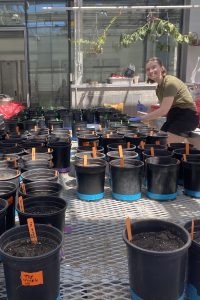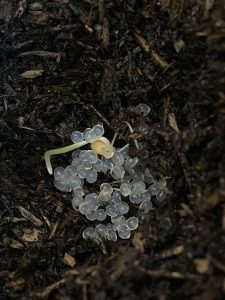Featured Research Accelerator Project : Applying Microbial-Plant Partnerships to Build Soil Carbon
Much of the world’s crop production relies on the application of conventional nitrogen and phosphorus fertilizers to soil. Although applied with the intention of providing sufficient nutrients to the crop to increase yield, much of the nutrients in the fertilizer go unused because many crops have poor nutrient use efficiency. This results in excess soil nitrogen and phosphorus, which then can leak into groundwater resulting in contamination and surface water eutrophication. Additionally, the application of nitrogen fertilizers is a major contributor to atmospheric

N2O emissions, and the production of industrial ammonia uses ~2% of the world’s energy and emits ~2% of atmospheric CO2.. Further, phosphorous is mined and is non-renewable and geopolitically constrained. Therefore, sustainable alternatives that can aid in fertilizer-use reduction while still increasing crop yield are needed. Our research focuses on understanding how plant-bacterial-fungal-substrate interactions can be leveraged as a sustainable biotechnology to rejuvenate soils back to a healthy state that promotes plant growth. We do this by encasing mycorrhizal fungi, nitrogen fixing bacteria, phosphate solubilizing bacteria, and other plant growth promoting microorganisms in biodegradable hydrogel beads that can be applied to soils.
This Program on Climate Change Grant enabled the Winkler Lab to further study the carbon sequestration capacity of our hydrogel biotechnology, which we call BioBead, and it also promoted the training of aspiring scientists (four undergraduates) who are passionate about implementing climate-smart solutions. Projects are ongoing, but we have currently completed the first greenhouse pilot study that focuses on both Sorghum and Sunflower as the crop. This study applied different types of our hydrogel technology to these two host plants. We found that our microbial hydrogels without biochar significantly increased soil organic carbon compared to the control, and when biochar was incorporated into the hydrogel construct with the bacterial-fungal consortia, soil organic carbon increased even more. In this study, we also explored the multi-functional potential for pollution remediation. We found that our microbial-biochar hydrogels significantly boosted remediation of certain pollutants in the soil, as well as pollutants leaching out from the soil. Currently, we are wrapping up a much larger scale greenhouse study on wheat that also compares different biochar types. This funding also helped enable a collaboration with a local farm who applied customized hydrogels to lettuce. We are excited to continue to move forward with more studies that help bring climate-smart solutions to the hands of farmers and other stakeholders.
